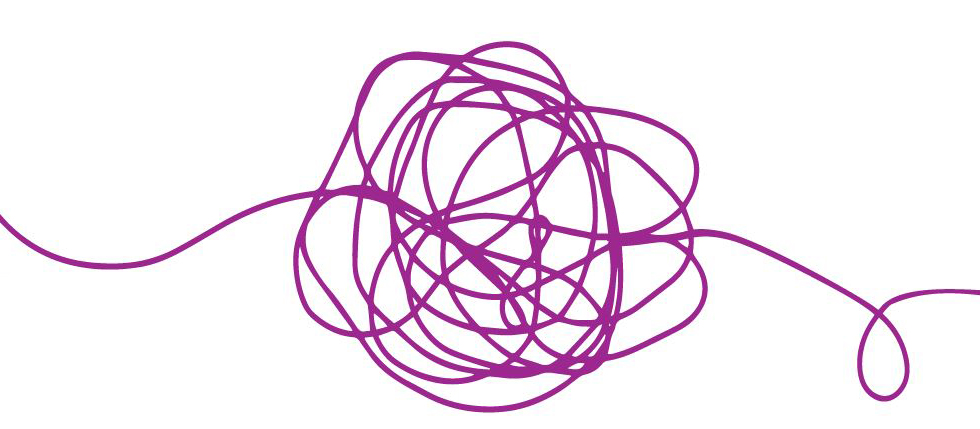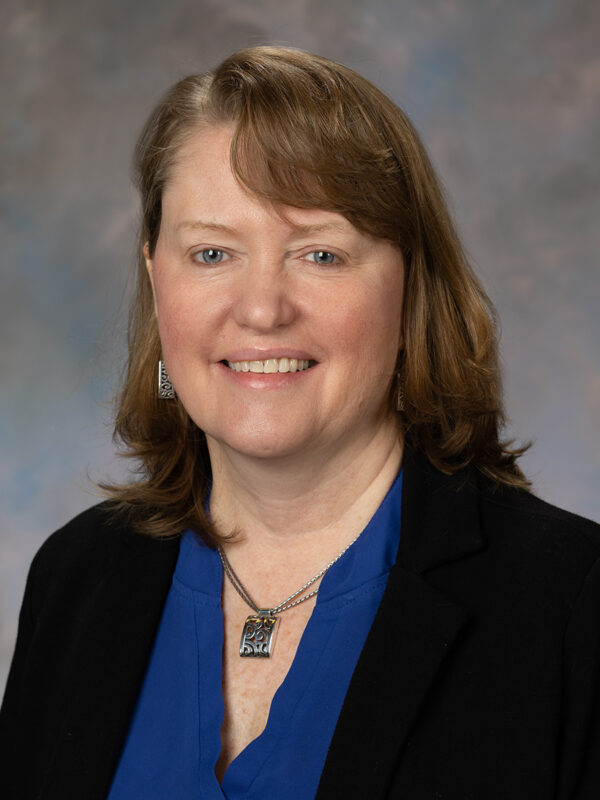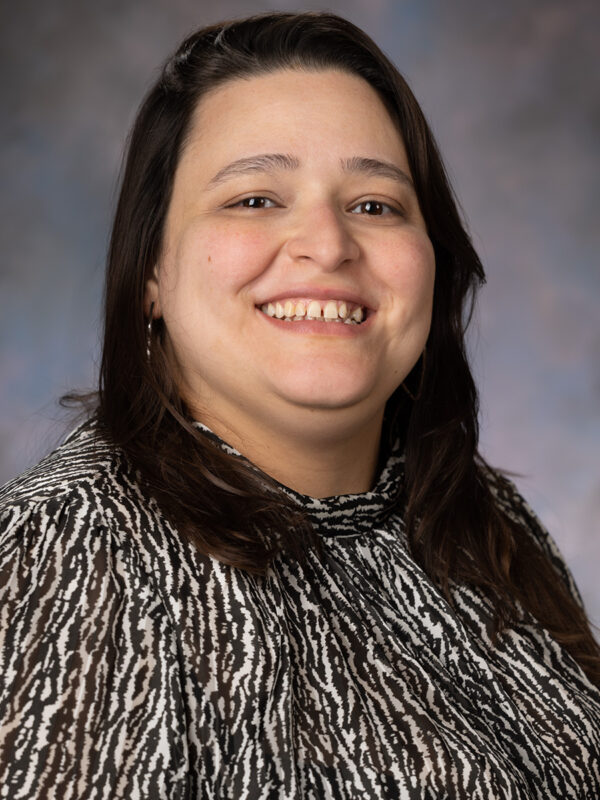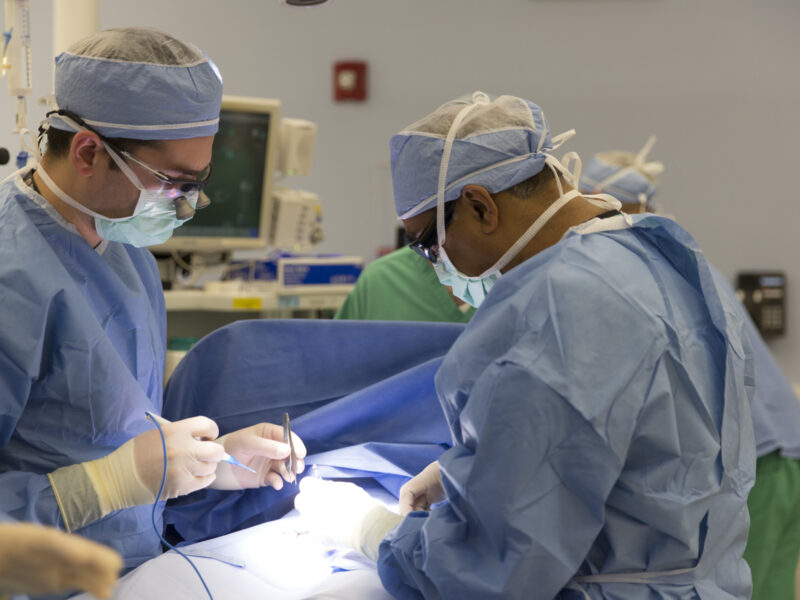Unraveling the Genetic Mystery Behind a Rare Pediatric Disease
Unraveling the Genetic Mystery Behind a Rare Pediatric Disease https://pediatricsnationwide.org/wp-content/uploads/2024/04/purple-thread-1-crop.jpg 980 429 Wendy Margolin Wendy Margolin https://secure.gravatar.com/avatar/?s=96&d=mm&r=g- April 19, 2024
- Wendy Margolin

Prune belly syndrome (PBS) is a rare, congenital urologic disease, affecting an estimated 1 out of 50,000 births. While most urologists will see fewer than three cases of PBS in their careers, Nationwide Children’s Hospital’s Linda Baker, MD, has treated more than 50 patients and met and counseled nearly 200 in the last 15 years. She directs the nation’s only multidisciplinary center dedicated to treating children with PBS and heads the only research lab in the United States studying the genetic cause of the disease.
Linda Baker, MD, loves a good puzzle. That’s part of what initially drew her to study one of pediatric urology’s rarest disorders, prune belly syndrome. Also known as Eagle-Barrett Syndrome, it affects the abdominal muscles, bladder, urinary tract, kidneys and – in males – testicles. Around 20% of babies with severe PBS don’t survive the first two weeks of life. Children with PBS face a lifetime of surgeries and treatment.
This rare disease that proves so difficult for children and their families is a research puzzle Dr. Baker has dedicated 15 years of her career to solving.
A pediatric urologist, principal investigator and co-director of the Kidney and Urinary Tract Center at Nationwide Children’s Hospital, Dr. Baker is one of few researchers in the United States working to identify the genetic causes of PBS and the only National Institutes of Health (NIH)-funded investigator studying it. “It’s so rewarding to discover something that’s never been discovered for a disease. Once we know what genes are at play, how the mutations work and cause the disease, we can develop treatments that might target the mutated genes.”
Working closely with PBS patients in the clinic has shown Dr. Baker how her research matters.
“This particular disease takes a huge toll on the whole family – physically, emotionally, financially and socially. If there’s anything I can do to help them, that’s the big motivator,” she says.
Features of Prune Belly Syndrome
Prune belly syndrome gets its name from the wrinkled skin of the abdomen. Children born with PBS have a soft, lax tummy area with partially formed muscles. There’s no blood test to diagnose the disease, but its features are apparent at birth.
For those with PBS, the urinary tract muscle is abnormal, which causes a massive, poorly contracting urinary bladder. The ureters are also typically very dilated. These abnormalities can cause reflux, urine blockages and significant kidney problems. For some babies in utero, when the urine doesn’t pass out of the bladder and into the amniotic fluid, the lungs don’t form properly. While some have two working kidneys, others have damaged kidneys or even kidney failure.
Male children with PBS typically have undescended testicles in the belly, which requires orchiopexy surgery by their first birthday. During pregnancy, a fetus with PBS will have an enlarged bladder. However, several problems can cause an enlarged bladder full of urine. The most common in males is posterior urethral valves, which is difficult to distinguish from prune belly syndrome in utero.
Treatment for PBS
Treating children with PBS takes a multidisciplinary team including urology, pulmonology, cardiology, nephrology, gastroenterology, nutrition, orthopedics and physical therapy. Nationwide Children’s is the only children’s hospital in the United States with a multidisciplinary PBS clinic.
The treatment pathway outlined in the box below can be complicated by infections that are common for kids with PBS, including urinary tract infections and pneumonia. Abdominoplasty surgery is highly complex. Patients should be treated in the ICU after this surgery to prevent pneumonia or a urinary tract infection and to maximize wound care and nutrition.
“You have to be prepared immediately after the abdominoplasty surgery because PBS patients might not always have the smoothest postoperative course,” says Dr. Baker.
With proper treatment, children with PBS can function well and live full lives.
“I know of individuals with prune belly syndrome who are PhD scientific researchers and are airplane pilots. Many people can do incredibly well,” says Dr. Baker.
Witnessing patients transition from a state of languishing to actively engaging in typical childhood activities is what Dr. Baker finds most rewarding. “When you start with a child who can’t stay out of the hospital, and then you get them through a major abdominoplasty and genitourinary surgical reconstruction, and they heal and are chasing their siblings, running and playing – it’s like you’ve given them a new life,” she says.
Treatment can be long and challenging. The typical intervention journey for PBS is as follows:
Birth-4 months: Lifesaving and kidney-saving measures and a vesicostomy.
4-12 months: Once medically stable, surgeries can include orchiopexy, abdominoplasty, early-stage urinary tract reconstruction and hip dysplasia repair.
1-5 years: Any of the above surgeries that couldn’t be performed earlier, urinary tract reconstruction for urinary continence, GI tract surgery.
5-11 years: Urology and nephology follow-up every 6-12 months, annual follow-up with other specialists as needed.
11-18 years: Close monitoring of kidney and bladder function through puberty, dialysis/renal transplantation if required, monitor and treat scoliosis.
18+ years: Monitor orthopedic joint complications, yearly renal ultrasounds, dialysis/renal transplantation if required, monitor fertility status.
Researching a Rare Pediatric Disorder
Dr. Baker began studying PBS over a decade ago after advancements in genetic sequencing opened up new research capabilities. That, combined with a penchant for solving difficult puzzles, drew her to the cause.
The first clue indicating the disease could have a genetic cause is that 95% of PBS cases occur in males. Multiplex families with more than one child born with PBS provide additional evidence, supporting the idea that genetics is a likely cause.
“It seemed to me that it was a disease in need of attention and we might be able to understand genetically what causes it,” says Dr. Baker, who has an R01 grant from the NIH to investigate mutations and cellular and molecular processes associated with PBS.
But to make progress, Dr. Baker would need access to a lot of patients with PBS. Like any rare disease, finding a significant sample size is challenging. The disease is so rare that some pediatric urologists will never see a patient with PBS in their years of practice. Dr. Baker partners with the Prune Belly Syndrome Network (PBSN) to identify research participants and share research results with families affected by PBS. Today, Dr. Baker has treated over 50 patients with PBS and connected with nearly 200.
Unraveling the Basic Mechanisms Behind Prune Belly Syndrome
No one gene causes PBS, so finding the combination of mutations is like unspooling a knot of threads with multiple ends and directions. To date, three key discoveries have brought Dr. Baker and her lab closer to understanding the genetic changes.
X-linked Filamin A Gene
Dr. Baker and her research team’s first DNA mutation findings were in two half-brothers and two unrelated children with PBS. The mutations were in the gene for
filamin A – a protein that regulates how cells detect stretching and contraction. This means there’s a mechanotransduction problem with the cells.
“That was a fascinating discovery that made a lot of sense because the filamin A gene is on the X chromosome,” she says.
With her long-time research partner, Nathalia Amado, PhD, Dr. Baker’s lab developed a mouse model with this same mutation. When the pregnant animal
experienced low oxygen during pregnancy, the male offspring were born with the PBS phenotype.
“This greatly deepened our understanding of what’s wrong in the cells of children with this syndrome and has led to more research,” she says.
PIEZO1 Gene
Dr. Baker’s lab team found DNA mutations among PBS patients in another gene called PIEZO1, which codes for a protein that acts as a pressure sensor on a cell’s surface. PIEZO1 is found throughout the lower urinary tract and is responsible for making a channel that helps the body respond to mechanical forces.
This discovery, published in January 2024 in Nature Communications, is providing additional evidence that children with PBS have defects that keep their muscle cells from responding properly to forces, such as the bladder’s ability to stretch and contract. Dr. Amado says this discovery was particularly exciting.
“You have in your mind how you believe it will work, but until you test it, you don’t know. It’s a eureka moment when it comes together,” she says.
“You have in your mind how you believe it will work, but until you test it, you don’t know. It’s a eureka moment when it comes together.”
— Nathalia Amado, PhD, postdoctoral scientist in the Kidney and Urinary Tract Center at Nationwide Children’s
Myocardin
The other gene Dr. Baker and her team are studying is myocardin – an on-and-off switch for cells to become smooth muscle cells, like in the fetal bladder and ureter. They found five novel myocardin mutations in PBS cases, highlighting the genetic transmission from asymptomatic carriers. These findings support a decade of Nationwide Children’s research on myocardin by Ashley Jackson, PhD, principal investigator in the Kidney and Urinary Tract Center, and Kirk McHugh, PhD, director of the Nephrology and Urology Research Affinity Group at Nationwide Children’s and professor at The Ohio State University.
“Each discovery at the cellular level showing how these genes and proteins work together is one more piece of the puzzle,” says Dr. Baker. “I started working on this hypothesis that the cause is genetic, and we’re starting to see evidence of that. It’s very rewarding to discover something new.”
Beyond Genetics: Improving Care
In addition to studying the genetic and molecular mechanisms behind PBS, Dr. Baker partners with colleagues at Nationwide Children’s to support treating children with the disease. In one study, psychologist Canice Crerand, PhD, a principal investigator in the Center for Biobehavioral Health, works with kids who have body image concerns to help them manage their quality of life and improve their mental health.
Linda Lowes, PT, PhD, and Melissa Smith, PT, DPT, principal investigators in the Center for Gene Therapy at Nationwide Children’s, specialize in neurodevelopmental pediatrics and study the physical function of individuals with PBS. As physical therapists and researchers, they seek to understand how well the muscles of babies, children and adults with PBS work to improve development.
Children with prune belly syndrome have a floppy abdominal wall that causes a different gait, making stairs and sports challenging. Kirsten Tulchin-Francis, PhD, director of the Honda Center for Gait Analysis and Mobility Enhancement at Nationwide Children’s and a gait expert, can analyze PBS patients’ gait to make adjustments and prevent the progression of scoliosis, arthritis and joint problems.
From Bench to Bedside
Researching the basic science behind PBS has the potential to improve kids’ lives. Dr. Baker and her growing research team have made progress in uncovering the genetic causes of PBS, but there’s still a long way to go. They hope to have some therapies and treatments in clinical trials within 5-10 years.
Working one-on-one with patients keeps Dr. Baker focused on why she’s dedicated to finding a treatment.
“All you have to do is look at some of these kids and talk to these families, and your motivation always stays high. They’re the whole reason I do this,” she says.
To develop a treatment, they’ll need to know more about the genetic causes of PBS.
“It bothers me that I still don’t have the answer for what causes prune belly syndrome in the majority of kids, even though I’ve already spent 10 years of my life trying to answer that question,” she says. “So long as I don’t have the answer, I’ll keep asking questions.”
The PBS studies are still recruiting research participants. Contact prunebellysyndrome@NationwideChildrens.org for more information.
This article appeared in the Spring/Summer 2024 issue. Download the full issue.
References:
- Amado NG, Nosyreva ED, Thompson D, Egeland TJ, Ogujiofor OW, Yang M, Fusco AN, Passoni N, Mathews J, Cantarel B, Baker LA, Syeda R. PIEZO1 loss-of-function compound heterozygous mutations in the rare congenital human disorder Prune Belly Syndrome. Nature Communications. 6 Jan 2024;15(1):339.
- Iqbal NS, Jascur TA, Harrison SM, Edwards AB, Smith LT, Choi ES, Arevalo MK, Chen C, Zhang S, Kern AJ, Scheuerle AE, Sanchez EJ, Xing C, Baker LA. Prune belly syndrome in surviving males can be caused by Hemizygous missense mutations in the X-linked Filamin A gene. BMC Medical Genetics. 2020;21(1);38.
- Fusco AN, Mathews JA, Coco CT, Egeland TJ, Cantarel BL, Amado NG, Baker LA. Myocardin loss of function variants down-regulate smooth muscle development in prune belly syndrome (PBS). Journal of Urology. 2021 Sep 12;206(3S):e898-899.
Image credits: Nationwide Children’s
About the author
-
Wendy Margolinhttps://pediatricsnationwide.org/author/wendy-margolin/April 19, 2024
- Posted In:
- Clinical Updates
- Features
- Research








